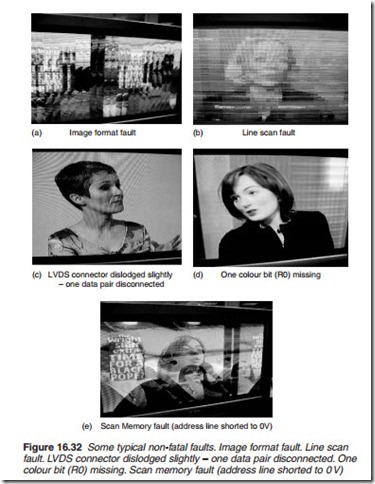Pixel defects
This may be a single pixel failure or several pixel failure or cluster failure. They both point to a fault in the panel itself. Examples of these have been illustrated in Chapter 10.
Picture faults
These include no picture or broken picture and/or multiple images and/or colour distortion. The classic no picture is when the set is stuck in standby. In this case there will be no sound either which generally but not exclu- sively points to a power supply fault. This is covered later in this chapter. No picture with normal sound suggests a video, a display formatting, a sustain, a scan or a data drive, a power supply or a display panel fault. Press Menu or another option for an on-screen display. If that appears on the screen, then the fault precedes the image scalar. If OSD is not dis- played, the possible fault may lie in the image scalar, the LVDS chip and connector, the scan, sustain or data drives, the power supply or the PDP itself. Check the output of the LVDS transmitter at the LVDS connector. A square wave will be present on the data line if video is missing and the LVDS transmitter is working properly. Also check the LVDS clock. Check the inputs and outputs of the scalar chip, sustain and scan drive wave- forms and the power supply.
A fatal fault in one of the processing chips such as colour decoder, image scalar, LVDS encoder or sub-field processor will normally result in no picture with sound OK. A fatal fault in memory chips (flash, NVRAM, SDRAM) will also result in no picture and no sound with the set normally stuck in standby. Similarly, the absence of clocks, control signals such as Enable, Chip Select and signals on I2C bus lines will result in no picture or stuck at standby. However, a partial fault such as a dry joint in a memory or processing chip, a data or address line stuck-at-zero or one, or a loose connection will result in non-fatal fault with a picture breakup and/or multiple images and/or colour distortion. Typical symptoms of non-fatal faults are illustrated in Figure 16.32.
